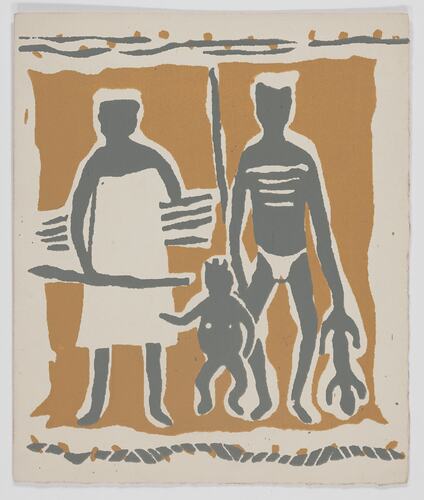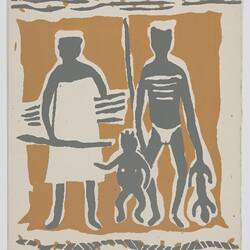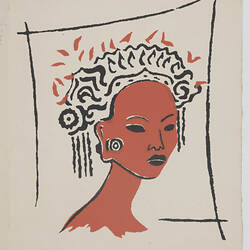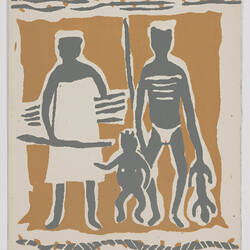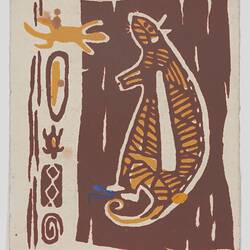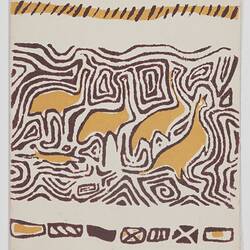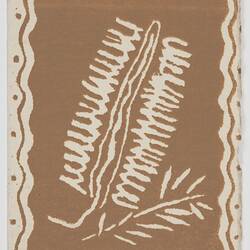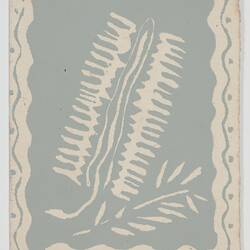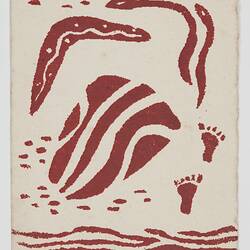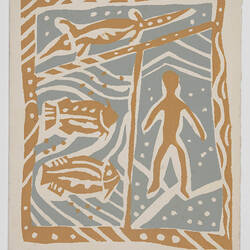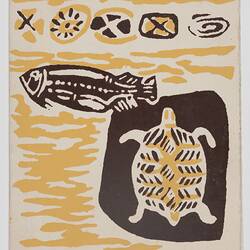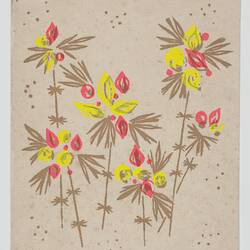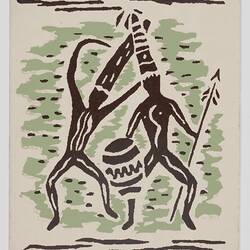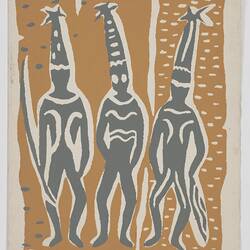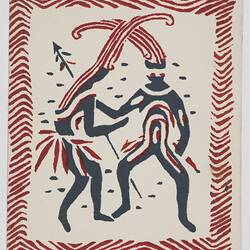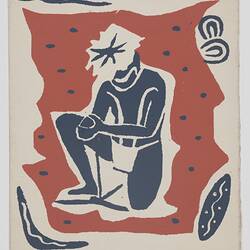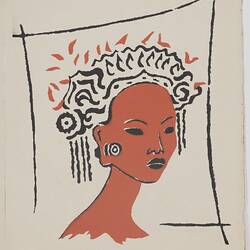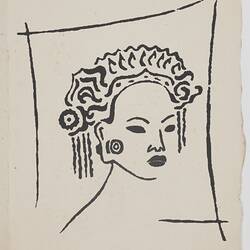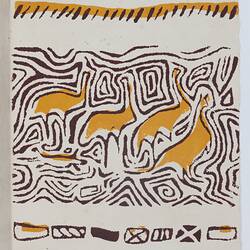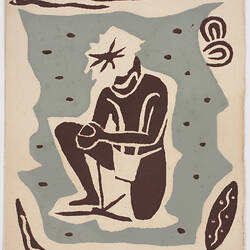Summary
Off-white greeting card printed in grey and mid-brown with image of three people: man, woman and child. The man holds a spear; the woman holds what may be a digging stick, and appears to carry a bundle of timber. The inside right side of the card is printed in red and black with the head and shoulders of a woman in traditional Balinese-style (?) headdress outlined in black with red detail - the same image as HT 24693 and HT 24696. The images reference traditional artwork from Australia and Asia.
Probably by John Rodriquez around the late 1940s to early 1950s, when he began printing cards and handkerchiefs on his kitchen table.Museum Victoria has acquired a representative sample of the card series: 0052, 0053, 0055, 0057, 0065, 0066, A0068, A0070, A0071, A0073, A0076, A0078, A0085, 0088, plus four unnumbered cards. Only card A0076 - HT 24673 - is dated on the card: 'printed 1954'.
John Rodriquez studied art and design at RMIT in the late 1940s and became well known for his screen-printed textile designs in the early 1950s. From 1950 to 1980 he was one of a handful of Australian textile designers who developed a new contemporary style with innovative use of colour. His designs in the early 1950s were mostly of Aboriginal or geometric style. Later he turned to more abstract designs in the Scandinavian style. Later still he made bold use of colour. Rodriquez introduced unique Australian styles which have been imitated often since. He always stressed the importance of innovation. Many homes in Australia and overseas still have his art works in the linen cupboard.
John Rodriquez retired in 1988, handing the Rodriquez company to his son Rimian, who has computerised the screen printing and mostly employs other designers for the products, but still uses a few of his father's most popular designs. Rodriquez passed away in 2000.
Physical Description
Off-white printed card, hinged at side. Printed in grey and mid-brown with image of three people: man, woman and child. The man wears a loincloth holds a spear and dead animal; the woman wears a sarong-like cloth, holds what may be a digging stick and appears to carry a bundle of timber. The child is naked. They are depicted against a mid-brown background, with linear and dot pattern above and below the image. The inside right side of the card is printed in red and black, featuring the head and shoulders of a woman in traditional Balinese-style (?) headdress outlined in black with red detail. The headdress extended from ear to ear, with lines at each end suggesting hanging elements.
Significance
See Narrative 'John Rodriquez Textile Collection'.
The significance of this object lies, in part, in its use of Aboriginal imagery. The use of Australian motifs, including Aboriginal imagery, flora and fauna, became fashionable during the 1940s and 1950s. These motifs expressed a growing sense of Australian identity while the nation was experiencing the social upheavals of war and mass migration. Many immigrant artists also began to adopt these motifs as they settled into their new country. Aboriginal imagery expressed complex attitudes to Australia's first inhabitants: as culturally interesting, representing connection to place and landscape, yet signifying a distant, pre-civilised time, in contrast to modern Australia. The fact that much of the Aboriginal imagery was appropriated without permission or compensation was far from the thoughts of most commercial artists of the time.
More Information
-
Collection Names
-
Collecting Areas
-
Acquisition Information
Donation from Ms Patricia Rodriquez, Apr 2010
-
Artist
John Rodriquez, Melbourne, Victoria, Australia, circa 1949-1955
-
Place & Date Manufactured
-
Inscriptions
Stamped on back: 'A0071'.
-
Classification
-
Category
-
Discipline
-
Type of item
-
Overall Dimensions
128 mm (Width), 152 mm (Height)
-
Keywords
Aboriginal Art, Artworks, Handcrafts, Screen Printing, Innovation & Design
